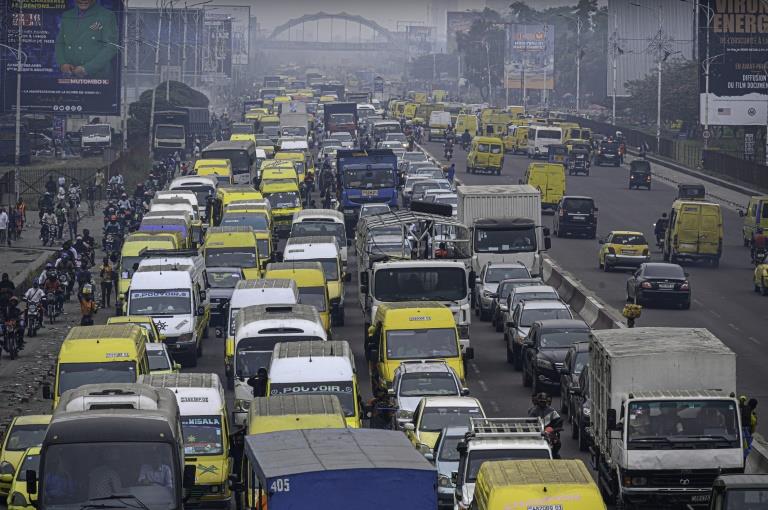
Kinshasa, a megacity of traffic jams, potholes, transit chaos
Cable car, urban rail LINK or ring road -- Kinshasa has big plans for alleviating its traffic chaos but for now, travelling into the megacity remains a daily headache for millions of people.
Viviane Yuka leaves for work at 5:00 am every day to battle through the Congolese capital's clogged-up streets where motorbikes, packed buses and taxis compete for space.
The city has 17 million inhabitants across 24 communes but still has no real public transport system and nearly all the passenger vehicles on its roads are privately owned.
"We suffer so much to find transport, we often go long distances on foot," Yuka, who sells brushes and brooms at one of Kinshasa's sprawling markets, told AFP.
Once aboard one of the yellow minibuses -- a mode of transport ominously known locally as the "Spirit of Death" -- passengers endure the "suffocation" of being crammed in like sardines, the mother said.
She never knows exactly how much she will be charged.
A lack of standardised fares means she can pay anything from 4,000 to 8,000 Congolese francs, about $1.5 to $3.
"The state must take responsibility by determining the price of each journey, as was the case in the past," ticket seller Maitre Brice said.
On many roads, including some considered main thoroughfares, deep potholes or pools of dirty stagnant water are not uncommon.
After a river burst its banks some months ago, part of a road near the University of Kinshasa in the west of the city is still submerged.
Motorbike taxi driver Leon Kumba Hamba, who takes the road every day, ponders whether the authorities have ever dared driving on it themselves.
It's so bad, he now charges customers between 3,000 and 5,000 Congolese francs to cross the submerged street to the university, instead of the usual rate of 1,000 francs.
"We suffer so much... it's so annoying," the 31-year-old grumbled, his shoes and trousers soaked from the water.
- 'Nothing has been done' -
Infrastructure projects to tackle the problems have been launched but most have barely got started.
All the while, Kinshasa continues to expand as its population grows.
The envisaged cable car would link up densely populated neighbourhoods in the southern Mont-Ngafula district and ease mobility.
But Robert Ndaka said that since the project was first talked about in the middle of last year "we have heard nothing, nothing has been done".
"We do not know if it is real or not," the geological engineer said.
The cable car could provide a "small solution" to the city's traffic woes, Ndaka added -- but there is still one problem with the idea.
Kinshasa suffers regular power cuts.
"We don't know how we will be able to use it, it's better to use dirt roads," Ndaka said.
Last month, President Felix Tshisekedi launched another project, a planned 63-kilometre (nearly 40-mile) ring road, due to start in the Mitendi area of Mont-Ngafula.
It will be a "high-speed asphalt ring road... with two lanes in both directions", according to the presidency.
Construction is estimated to last three years, at a cost of $300 million.
An urban train link, called Metrokin, is also in the pipeline.
French company Alstom confirmed to AFP that it has signed an initial partnership agreement with the Congolese state to carry out the work.
It is set to begin with the renovation of a 25-km stretch of railway line from Kinshasa central station in the north of the city, to Ndjili international airport on the eastern outskirts.
But for now, the thousands of passengers desperate to get into the city need to be up before dawn ready to scramble onto an antiquated train.

Legal Disclaimer:
MENAFN provides the information “as is” without warranty of any kind. We do not accept any responsibility or liability for the accuracy, content, images, videos, licenses, completeness, legality, or reliability of the information contained in this article. If you have any complaints or copyright issues related to this article, kindly contact the provider above.
Most popular stories
Market Research

- Manuka Honey Market Report 2024, Industry Growth, Size, Share, Top Compan...
- Modular Kitchen Market 2024, Industry Growth, Share, Size, Key Players An...
- Acrylamide Production Cost Analysis Report: A Comprehensive Assessment Of...
- Fish Sauce Market 2024, Industry Trends, Growth, Demand And Analysis Repo...
- Australia Foreign Exchange Market Size, Growth, Industry Demand And Forec...
- Cold Pressed Oil Market Trends 2024, Leading Companies Share, Size And Fo...
- Pasta Sauce Market 2024, Industry Growth, Share, Size, Key Players Analys...





















Comments
No comment